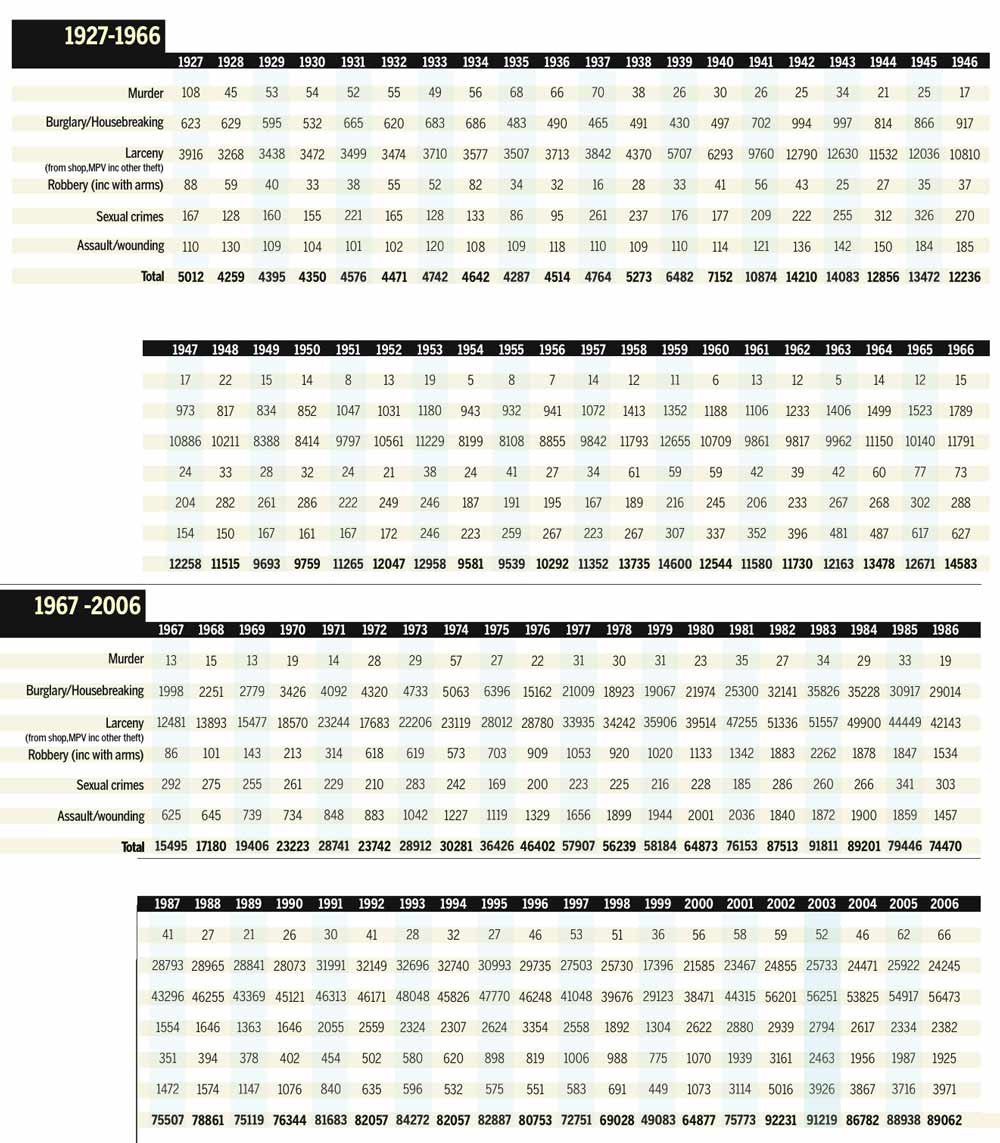There is no crime crisis
Statistics from 1927 show that while the incidence of reported crime has risen the level of crime per head of the population has remained static or declined in the last 23 years
We do not have a crime crisis. There were reasons in the mid-1980's when there were grounds for thinking there was a crime crisis because in the previous 14 years the incidence of reported headline crime jumped fourfold, from 25,972 to 102,387. But even then a crime panic would have been excessive for most of the major component of this increase was larcenies (from 15,477 to 51,577).
Since 1983 the crime figures have oscillated from around 73,000 (in 2000) to 103,710 (in 2006). And throughout this period the major component again has been the least significant of headline crimes, larcenies (veering from around 56,000 to 23,000).
Homicides have risen in recent years from 21 in 1989 to 66 in 2006 but because the homicide rate is very low (in 2006 it was 0.017 per thousand) it is susceptible to variations of a freak nature and that seems to have been a factor of late. The homicide rate was significantly higher in the period from 1927 to 1937. It dropped dramatically in the 1940's, 1950's and 1960's.
The year 2006 saw the highest homicide incidence (66) since 1937 but the majority of homicides has to do with personal or domestic factors than, for instance, gangland killings. (We have used the term “homicide” so as to make valid comparisons with pervious years – since many “murders” subsequently are classified as manslaughter, we have used the generic term. Homicide includes murder, manslaughter, infanticide and dangerous driving causing death.)
The incidence of reported sexual crimes has risen from 167 in 1927 to 255 in 1969 to close to 2,000 in 2006 but these figures are largely meaningless. The incidence of reported sex crime as a proportion of total sex crime is very low and depends entirely on cultural factors to do with stigmas associated with sex crimes and the indignities women in particular feel as a consequence of reporting such crime.
Another facet of serious crime has to do with assault/wounding. This figure has certainly risen significantly from 110 in 1927 to nearly 4,000 now. A change in the way this crime has been recorded in Garda statistics may account in part for this increase. While it is a cause for concern, the proportion of this to overall crime is very small – les than 5 per cent.
This is also the issue of the population increase.
In 1983 the population was around 3.5 million; it is now over 4 million. The headline crime rate in 1983 per 1,000 of the population was 29.3. The rate in 2006 was 26. And throughout the period from 1983 to 2006 the rate per 1,000 of the population was have been either static or in decline.
A factor in the growth of the reported crime figures has been house, property and car insurance. As a consequence of more people having insurance policies the incentive to report relatively insignificant crimes is increased. This would account for a significant part in the rise of the reported incidence of larcenies and, in pat, for a rise in the reported incidence of burglaries.
Another factor in the rise in the crime rate has been the greater availability of motor cars. Cars offer would-be criminals mobility they did not previously enjoy. Cars also have contributed to the breakdown of community ties and therefore weakened the bonds of solidarity and support.
We have based these figures on date available from “Crime and Punishment in Ireland 1922 to 2003” (published by the IPA and the Institute of Criminology, UCD, funded in part by the Department of Justice, Equality and Law Reform) and the annual crime statistics report published by An Garda Síochána and more recently by the Central Statistics Office.
The statistics were compiled by Tom Rowe. To enlarge the statistics, click on the image.

